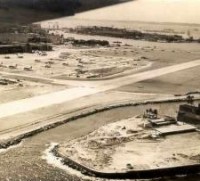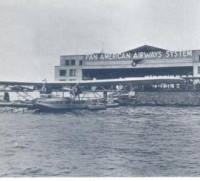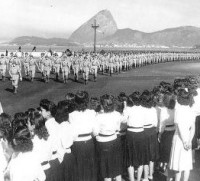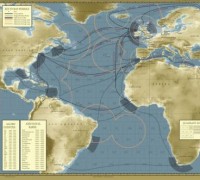BRAZIL THE FORGOTTEN ALLY - BRAZIL X USA
7)STRUGGLE FOR MARKETS
WHAT DID YOU DO IN THE WAR ZE CARIOCA?
By Frank Mc D. Cann. University of New Hampshire.
The failure of the world economy after the Wall Street Crash of 19291 led to intense competition among Britain, the United States, and Germany over access to Brazil's market and resources. This rivalry was especially important for the latter two countries, which had limited avenues into the vast areas of Africa and Asia that were under colonial rule. The United States turned to Latin America using the famous Good Neighbor Policy and its companion reciprocal trade treaties as vehicles to increase commerce, in order to stimulate the stagnated national economy. Germany's vehicle to achieve the same end was the compensation mark (Aski) system, a bi-lateral, blocked account arrangement that shut out third parties.
Shortly after Secretary of State Cordell Hull signed the trade treaty (Feb. 1935) with the government of Getúlio Vargas, the Brazilians made an agreement with Berlin to trade in the Aski system as well. Washington's desire for liberal trade policies based on purchases in hard currencies was not matched in Rio de Janeiro or Berlin because both lacked such currencies. Brazil needed its scant hard currency reserve to support the Milréis (Cruzeiro replaced it in 1942), pay off foreign bond holders, remit the profits of foreign companies, and finance purchases in the United States and other countries.
To obtain dollars, for example, the Brazilians looked to the United States as the principal market for their coffee, which, in the 1930s, was facing growing competition from Central American, Colombian, and Venezuelan shippers. That was why Germany was so appealing; there Brazil could enlarge its exports and buy manufactures without spending hard currencies. The Aski system allowed the Germany to offer lower prices than their American or British competitors; indeed, the prices were more favorable than those listed in Reichmarks. In 1938, Brazilian importers of German goods paid Aski mark prices that were 24% less than those in Reichmarks.
In addition, Germans bought Brazilian cotton, wool, and fruits such as oranges, which the Americans did not want. And because Brazilian and American cotton competed directly in the German market -indeed American losses reportedly had reached $20 million in 1935-, the Brazilians believed that the Roosevelt administration's pleas for open trade were not as detached as the Americans professed.
The heart of the American-German conflict over the Brazilian market was that Brazil's Aski-based sales obligated it to buy German products that competed with American ones. In effect, Brazilian competition cut finto American cotton sales to Germany, while the Aski-system reduced American sales to Brazil. This aspect of the situation worried the Brazilians as well.
By the mid-1930s, the Vargas government had greatly weakened Britain's long- time financial dominance over the economy and was attempting to create an economic relationship with the United States that would give the Brazilian economy access to American loans, investments, and markets, while minimizing American influence.
However, having enfeebled John Bull's hold, the Brazilians were anxious to avoid Uncle Sam's grip, and they did not want to give the Germans undue influence over their trade policies. Their idea was simple and direct: by multiplying the number of players, they would increase their ability to maneuver among them; by expanding their markets and sources of supply, the economy would be less dependent on a particular power and the political system would be less vulnerable to foreign penetration. They wanted to trade wherever possible, on whatever terms were agreeable; they were less troubled about trade mechanisms than about finding markets and selling goods.
Their objective was economic independence, which they saw as necessary to maintain political autonomy and to further economic development. The Vargas government's skillful, clever, and nationalist maneuvering built the foundation of today's robust industrial park. Back then, few thought that Brazil would become the eighth-ranked industrial economy in the world. The 1935-1945 period provided opportunities for Brazil to make great strides forward, and its leaders seized the chances with hard-headed determination.
The tendency toward trade diversification, which so characterizes Brazil's foreign trade in the 1990s, had its origins in the 1930s. Then, as now, it was a common-sense way of minimizing risky dependence. It was and is better to have more than one buyer and more than one supplier.
The difficulty for historians, of course, is that Nazi Germany was a major actor in this story and dealings with the Reich raise suspicions of sympathy and partisanship, particularly because, in November 1937, Vargas ended the constitutional, elected government that he had headed since 1934, and replaced it with the dictatorial Estado Novo, (New State)
American diplomats and intelligence agents saw the street parades of the fascist-like, green shirted Integralistas (although not related to the government and suppressed in March 1938), and the open admiration for the German army of the Brazilian officers who backed the dictatorship, as signs of Nazi influence. Truly, trade does not take place in an ideological vacuum, but it is well to recall that the United States government and American businesses were working hard to expand their own access to the German market.
In the twentieth century, the Brazilian market has been important to Germany under all of its regimes -imperial, Weimar, Nazi, occupied, Bonn, and now reunified. In 1938, Brazil was the biggest non-European consumer of German products and ranked ninth among Germany's trading partners overall. And Brazil's relations with it have been qualitatively different than with the United States because, like its North American partner, it received a large German immigration in the nineteenth century, which gave Germany an influential base from which to operate. The Americans lacked a similar base, immigration from the United States having consisted of a few families of disgruntled Confederates.
With half a century of hindsight, it is obvious that Germany's trade was supporting its preparations for war, but it should be equally obvious that Brazil's leaders had no more idea than anyone else that Germany would soon unleash the greatest war in history. The point is that, until the war, none of the future allies abstained from trade and other dealings with the Third Reich.
While Brazilian importers bought a wide-variety of products in Germany in 1938-1940, they could not do so rapidly enough to maintain a balanced exchange. Extensive German purchasing stimulated certain sectors of the economy, but caused the Bank of Brazil to amass a huge cache of Aski marks. It was a delicate situation. In mid-1938 the Bank found itself holding an excess of 30 million Aski marks and unofficially stopped authorizing exports against the Aski account, and insisted that Germany pay for cotton in hard currencies.
The Germans threatened to buy elsewhere. If Berlin fulfilled its threat, the producers of cotton, coffee, cacao, tobacco, rubber, wool, woods, tropical fruits, hides, butter, and iron ore would be seriously hurt. A few examples from 1938 will show the importance of Germany's trade to the Brazilian economy.
Where coffee was Brazil's principal export to the United States, cotton was the leader in its trade with Germany. Germany imported 1,211,182 bales of raw cotton, of which 466,364 landed from Brazil, 200,170 from the United States, 136,953 from Egypt, and 407,695 from various other sources. And because the cotton lobby kept Brazilian fibers out of the American market, the Brazilian government was quite happy to see sales to Germany increase. Brazil sold Germany 41% (91,789,700 kilos) of the 197,419,700 kilos of coffee that it imported, and Berlin was promising to reduce Colombia's and Venezuela's quotas.
In cacao, Germany was Brazil's third-ranked market after the United States and the United Kingdom; it took 10,599 tons of the total 127,887 tons shipped abroad, thereby exciting exporters about this new market. Also in 1938, 14% of Germany's tobacco carne from Brazil. And rubber and wool producers were particularly interested in that market. Although wild rubber production was declining, of the 8,819 ton yield, fully 6,715 tons, or 77%, went to the Reich. These figures had enormous importance for the weak Amazonian economy.
Similarly, wool producers had been pleased to sell Germany 88% of their 1936 shipments and 97% of their 1937 ones. When the percentage dipped to 40 in 1938, they were naturally alarmed. The Vargas government necessarily had to pay more attention to its citizens' interests than to the complaints of the United States about unfair trading practices. It gave in to German desires to continue the Aski trade. Fortunately, the trade pattern during 1938 had allowed the Brazilians to reduce their surplus of Aski marks to about 5,000,000. Trade between the two countries continued to be based on the system until the war brought it to an end.
Washington provided credits to flnance exports to Brazil, without increasing Brazilian exports to the United States. American quotas for coffee and cacao, and exclusion of cotton, did not permit expansion, while Germany's system encouraged continuous expansion of Brazilian exports. The Brazilians interpreted American policies as intended to hold back the Brazilian economy.
The United States sold more than it bought, demanded dealing in hard currencies, and extended loans and credits that could be used only for purchases in the American market. While it was not helping Brazil earn hard currencies, the Roosevelt administration protested that Brazil was not paying on its hard-currency bond issues and debts.
The policy conflict was heightened by Washington's objections to Brazil's arms purchases in Germany, made with mixed hard-currency and Aski marks. American refusal to sell arms because of congressional prohibitions against exporting them was difficult for the Brazilian military, then intent on modernization, to understand.
In the mid-1930s, Brazilian intelligence estimates pointed to the United States as a possible security threat, so American objections to purchases in Germany and refusal to sell aroused suspicion as well as irritation. [Moreover, the military was fearful of Argentine intentions and nervous that, after Paraguay's mobilization for the Chaco War (1932-35) with Bolivia, it could use its 77,000 man army to seek a more favorable definition of its boundary with Mato Grosso.
In addition, officers worried about Nazi organizations among German immigrants in the southern states. As a result, top military leaders were intimately involved in shaping trade policy. The military also supported the idea of securing foreign assistance to develop a steel industry as the basis for future industrialization and independent arms production.
The United States did not apply strong economic pressures on Brazil to end the Aski trade. It was personally embarrassing for Secretary of State Cordell Hull to have the largest country in the Good Neighborhood undermining the reciprocal trade treaty system around which he had molded Washington's foreign policy. The State Department contented itself with hearing Brazilian leaders' constant protestations of loyalty to pan-American ideals and refrained from the strong actions necessary to bring the Brazilians to heel.
The Americans accepted rhetoric over action because they wished to preserve the façade of a successful Good Neighbor policy, even though Brazil's participation in the Aski system was effectively a rejection of the principles of that policy.
As early as November 1938, the Brazilian Ambassador in Washington, Mario de Pimentel Brandáo, advised Foreign Minister Oswaldo Aranha that "we have to decide: The United States or Germany."
But Vargas saw Washington's worries about Germany and its desire to maintain a facade of pan-American unity, and Germany's need for raw materials and markets, as windfall sources of new leverage that he used to expand trade, obtain arms and assistance in building the Volta Redonda steel complex, all the while maintaining an internal political balance among the social, economic, and military groups supporting his Estado Novo.
His government's policy was to avoid placing all of its eggs in one basket until it absolutely had to, so that, in the words of American Ambassador Jefferson Caffery, it could "squeeze the maximum out of the United States on the one hand and the Fascist powers on the other."
Brazilian trade with Germany flourished until the outbreak of hostilities, and thereafter was shut off by the British naval blockade.
As German armies triumphed in Europe, Berlin offered to increase its purchases in Brazil after the war from a pre-war annual average of 170 million Reichmarks to 300 million Reichmarks. It promised arms, railroad equipment, and a steel mill. Everything depended on the outcome of the war and on Germany's postwar intentions.
As conquest added new millions to Germany's economic sphere, its importance as a post-war trading partner increased. But what if victory also brought Germany a colonial empire in tropical Africa that might one day supply the cacao, coffee, tea, tobacco, cotton, rubber, woods, etc., that it now obtained in Brazil? German analysts predicted that, eventually, trade with Brazil would "undergo certain changes and a contraction."
The Nazi government intended to invite German immigrants living in Brazil to move to the new colonies. From his post in Berlin, Brazilian Ambassador Cyro de Freitas Valle warned that the Reich's plans called for global spheres of influence based on "Europe for Berlin, the Americas for Washington and Oriental Asia for Tokyo." Russia would be the country-balance to the United States.
He thought that it would be better for the Germans to concentrate on winning the war rather than spinning such schemes, but it surely raised the question of where Brazil fitted into such a post-war world order. If a victorious Third Reich planned to leave Brazil in the American sphere of influence, would not the South American republic's leaders be wise to solidify ties with the United States?
The Brazilians intelligently carried on simultaneous negotiations with Berlin and Washington, seeking the best support for their plans to construct an industrial infrastructure. One have told the story of these negotiations elsewhere, suffice to say here that in September 1940, the Roosevelt administration came up with a funding package that did the trick. Washington, not Berlin, provided the wherewithal to build the Volta Redonda steel mill, which was both symbol and substance of Brazil's industrial coming of age.



